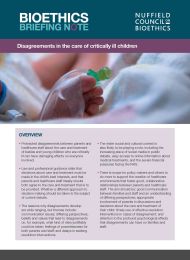Disagreements in the care of critically ill children
Policy Briefing
Published 03/04/2019

Current law and guidance
Professional guidance
Professional guidance for healthcare staff states that decisions about care and treatment must always be made in the child’s best interests, and healthcare staff should work in partnership with parents to explore what treatment options might be best in the child’s situation. Factors that should be considered include: clinical judgement about the effectiveness, risks and side-effects of a proposed treatment; the child’s physical and emotional needs, and religious or cultural background; and the views of the parents and others who are close to the child.7
The guidance acknowledges that decisions about care and treatment can be complicated by resource constraints. Ideally, decisions about access to treatments should be fair, based on the patient’s ability to benefit, and made on the basis of clear and consistently applied local or national policies.
Before any kind of medical intervention can be given to a baby or young child, the consent of the parents or guardians must be sought by the healthcare team (except in emergency situations where immediate steps need to be taken). This also applies to decisions to withdraw or withhold life-sustaining treatment. Parents can request a particular course of action, but there is no obligation on healthcare staff to provide treatment that they do not believe to be in the best interests of the child. In practice, this means healthcare staff and parents of young children and babies ideally should both agree to the care and treatment that is to be provided through a process of shared decision making.8
If disagreements arise, there is a range of resolution interventions that can be used (see Box 1). However, there is a lack of evidence on the availability of different resolution interventions in UK hospitals, how often they are employed, and how effective they are in different contexts.
The Royal College of Paediatrics and Child Health advice on managing conflict recommends that health professionals should: avoid giving inappropriate expectations, use palliative care teams early, recognise that parents will be under severe stress, support practitioners who may be caught up in the conflict, assign a lead clinician role to ensure continuity of information, and develop skills within the service to recognise the development of conflict. It also suggests external advice may be helpful, including ethical, legal and mediation services.
Court proceedings
If a disagreement cannot be resolved, hospitals must apply to the appropriate court for an independent ruling before proceeding with a course of action that the parents do not consent to. The laws in the UK state that, where a court is involved in making decisions about a child, the child’s welfare shall be the court’s paramount consideration.9 The United Nations Convention on the Rights of the Child says that “in all actions concerning children…the best interests of the child shall be a primary consideration”. The principle of best interests has become the ‘gold standard’ by which court judgements are guided.
The number of cases that are referred to the High Court in England regarding the medical care and treatment of children is thought to be in the region of 10 per year, but precise figures are unavailable.10 Several court cases have been discussed publicly over the past few years, including the cases of Charlie Gard, Alfie Evans, Ashya King and Isaiah Haastrup.
Box 1. Resolving disagreements
Disagreements are often resolved through discussion between healthcare staff and parents. To ensure discussions are holistic in nature, they can benefit from the involvement of others such as hospital chaplains, religious and community leaders, Patient Advice and Liaison Services (PALS), and palliative care specialists. Either party can seek a second expert opinion, although care should be taken to ensure this is viewed as independent by all parties. Some hospitals have access to clinical ethics committees, which can help identify the ethical values underpinning the disagreement, but they vary widely in their membership and processes. Mediation involving a neutral mediator is increasingly recognised as an appropriate method for attempting to resolve paediatric healthcare disputes. Court proceedings are available when an independent and authoritative resolution is required.
Challenging current approaches
There is debate about whether a different approach should be taken to decision making about the care and treatment of children.11 For example, ‘Charlie’s Law’ seeks to avoid court orders that prevent parents seeking treatment that another hospital will provide, unless that treatment is believed to pose a risk of significant harm to the child (see Box 2).
Other suggestions include the creation of decision making bodies that could be referred to before involving the courts, such as quasi-judicial bodies or ‘treatment review panels’ that would consider requests for treatment taking into account the patient’s situation and allocation of resources.12 Further examples of alternative approaches can be found in other countries. (For example, the Consent and Capacity Board in Ontario, Canada, is an independent tribunal that adjudicates on consent and capacity issues.)
Box 2. Threshold of significant harm
Charlie’s Law is a proposal being supported by the parents of Charlie Gard, Parliamentarians, academics, and health professionals. Charlie’s Law would allow parents to seek ‘disease modifying’ treatment for their child, as long as there is a reputable institution willing to provide it and the proposed treatment does not cause significant harm. If a risk of significant harm was identified, a court could be asked to decide what would be in the best interests of the child. Analogies have been made with care proceedings, where a court can only grant a care order where the child is suffering or is likely to suffer significant harm.13 In the case of Alfie Evans in 2018, the parents put to the court that the first question should be whether their proposals for Alfie’s care would be likely to cause him significant harm. The parents wanted Alfie to be transported to a hospital abroad and undergo treatment that might enable ventilation to be continued at home. The judgment stated: “The founding rule is that it is not lawful for them [doctors] (or any other medical team) to give treatment to Alfie which is not in his interests. A decision that, although not in his best interests, Alfie’s continued ventilation can lawfully continue because (perhaps) it is not causing him significant harm would be inconsistent with the founding rule”.
References
For a full list of references, download the PDF.
[7] A 5-year research project on the principle of best interests, led by Richard Huxtable at Bristol University, received funding in 2018. The project will explore how best interests is understood by those involved in decisions about the care of critically ill children, including parents; whether this is the best approach and language to use for all kinds of decisions; and whether best interests is the best approach.
[8] General Medical Council (2007) 0–18 years: guidance for all doctors; Department of Health (2009) Reference guide to consent for examination or treatment; General Medical Council (2010) Treatment and care towards the end of life: good practice in decision making; Larcher V et al. (2015) Making decisions to limit treatment in life-limiting and life-threatening conditions in children: a framework for practice (Royal College of Paediatrics and Child Health) Arch Dis Child 100(Suppl 2): s1–s23; Shared Decision Making Collaborative (2015) A consensus statement; BMA (2016) Children and young people ethics tool kit; Nursing and Midwifery Council (2018) The code.
[9] Children Act (England and Wales) 1989; Children (Scotland) Act 1995; The Children (Northern Ireland) Order 1995.
[10] Personal communication with Children and Family Court Advisory and Support Service (CAFCASS)
[11] See for example, Diekema DS (2004) Parental refusals of medical treatment: the harm principle as threshold for state intervention Theoretical Medicine 25: 243–264; McDougall R and Notini L (2013) Overriding parents’ medical decisions for their children: a systematic review of normative literature J Med Ethics 40: 448–452; Birchley G (2016) Harm is all you need? Best interests and disputes about parental decision-making J Med Ethics 42: 111–115; Cave E and Nottingham E (2017) Who knows best (interests)? The case of Charlie Gard Medical Law Review 26: 500–513; Bridgeman J (2018) A threshold of significant harm (f)or a viable alternative therapeutic option? J Med Ethics 44: 466–470; Gollop K and Pope S (2018) Charlie Gard, Alfie Evans and R (A Child): Why a medical treatment significant harm test would hinder not help; Wilkinson D and Savulescu J (2018) Ethics, conflict and medical treatment for children: from disagreement to dissensus; Wilkinson D and Savulescu J (2018) Alfie Evans and Charlie Gard—should the law change? BMJ 361: k1891; Archard (in press) ‘My child, my choice’: parents, doctors and the ethical standards for resolving their disagreement NILQ 70: 93–109.
[12] White D and Pope T (2016) Medical futility and potentially inappropriate treatment. The Oxford handbook of ethics at the end of life; Wilkinson D and Savulescu J (2018) Ethics, conflict and medical treatment for children: from disagreement to dissensus.
[13] Significant harm in defined in the Children Act 1989 as ill-treatment or impairment of health or development. It says consideration of what constitutes significant harm should include the degree and extent of physical harm; the duration and frequency of abuse or neglect; the extent of premeditation; and the degree of threats and coercion.

Share